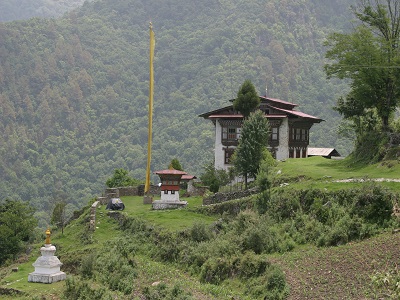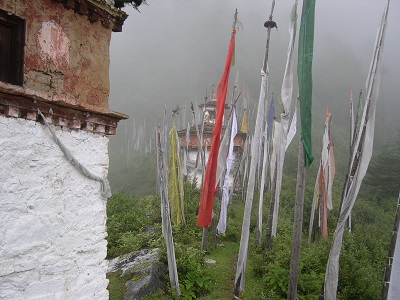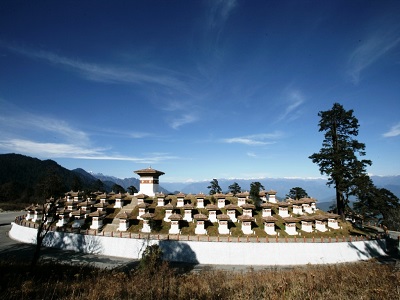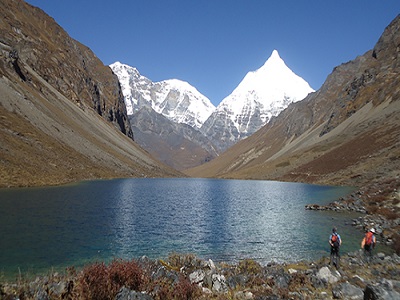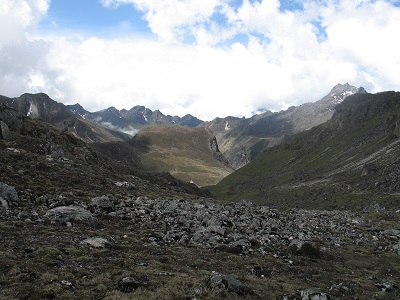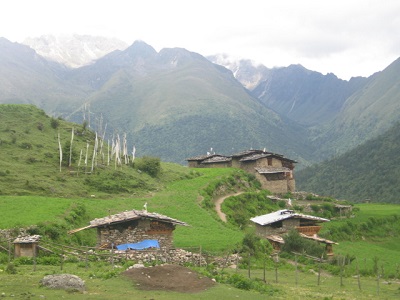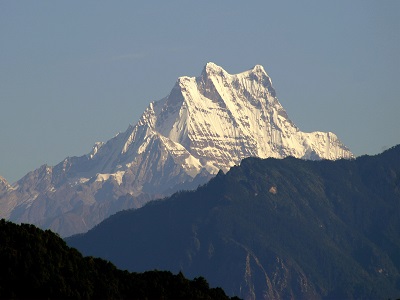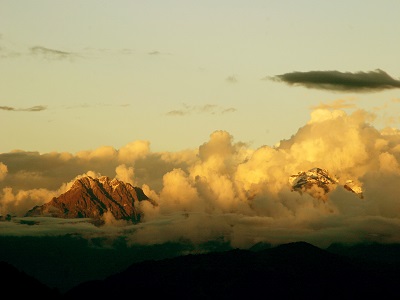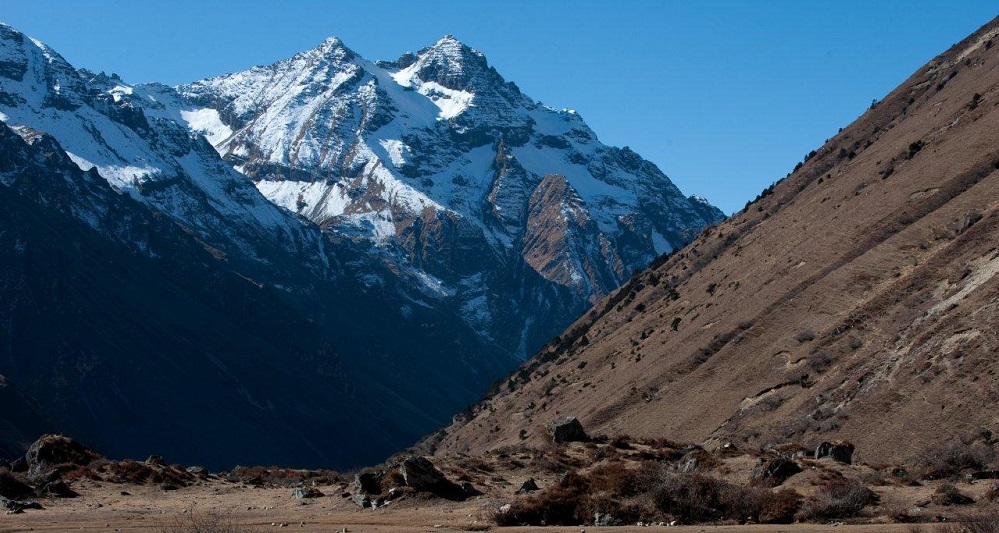
SEASON
Duration – 7 nights / 8 days
The trek is an extension of Jhomolhari trek and offers great opportunity to spot blue sheep. If you are lucky, you may also see Takin (national animal of Bhutan) and the Blue Puppy (national flower of Bhutan).
This trek is generally open from April to June and from mid September to mid November. However the best season for this trek is in April.
Day 1: Arrive Paro
On arrival at Paro, you will be received by the representative of Dragon Trekkers & Tours and will transfer you to a hotel in Paro
Day 2: Paro
Full day of sightseeing in Paro. Visit Ta Dzong (National Museum), Drukgyel Dzong, Rinpung Dzong and Kyichu Lhakhang. Overnight at the hotel in Paro.
Day 3: Paro–Shana (17 km 5/6 hours)
The trek starts from Drukgyel Dzong at an altitude of 2580m with a short downhill walk on a wide trail. The trail climbs gently through rice terraces and millet fields. The route enters into apple orchards and forests. Soon you will reach the army camp of Gunyitsawa (2810m). At 2870m, just beyond Sharna Zampa, there are several good places for camping surrounded by trees.
Day 4: Sharna–Soi Thangthangkha (20 km 7/8 hours)
The trek trail follows the Pa Chu(Paro river), ascending and descending through pine, oak and spruce forests. After crossing the bridge lunch will be served. Then follow the river climbing up through shrubs and rhododendrons and till you reach the camping site at an altitude of 3,750m.
Day 5: Soi Thangthangkha-Jangothang (19km 7/8hours)
The path follows the river above tree line. Soon you will reach at yak herder’s camp, where lunch will be served. Then you will be at Jangothang (4,040m). From there ,you can see the view of Mt Jhomolhari.
Day 6: Rest day at Jangothang
You can take a short walk and enjoy the beauty of nature.
Day 7: Jangothang-Lingshi (18km 7/8 hours)
The path continues to follow the stream for half an hour and crosses the bridge to the right side. Start the climb towards the north while enjoying the view of Mt Jhomolhari, Jichu Drake and Tsrim Khang. Then climb towards the Nyele pass at an altitude of 4,700m and descend to Lingshi camp. The camp lies at 4000m.
Day 8: Lingshi-Chebisa (10 km 5/6 hours)
Continue the walk passing by the Lingshi Dzong situated on the hill top with a captivating surrounding. It is a wonderful walk through villages and yak herder’s camps. After lunch, a short trek will take you to Chebisa village. Overnight in the camp by the side of the stream at an altitude of 3850m.
Day 9: Chebisa–Shoumuthang (17 km 6/7 hours)
The trek starts with stiff climb to Gubu La pass at an altitude of 4500m, which will take about four to five hours. After crossing the stream the trek route passes through rhododendron forest and yak header’s camps. Along the route, you may see the blue sheep. Camp at an altitude 4250m.
Day 10: Shoumuthang–Robluthang (18 km 6/7hours)
The trek starts with a climb to Jari la pass at where you will be at an altitude of 4700m. The route leads you to the valley of Tsharijathang, where the Takin (national animal of Bhutan) resides during the summers. Then follow the trail towards the left till you reach the camp where we will halt for the night at an altitude of 4250m.
Day 11: Robluthang–Limithang (19 km 7/8 hours)
The path climbs till the Shinjela pass (4900m) and then descends to Limithang. The last trek route is very interesting with the view of Mt Gangchey Ta. Arrive at camp site at an altitude of 4100m.
Day 12: Limithang–Laya (10 km 4/5 hours)
The trek to Laya is breathtaking with the view of beautiful mountains and snow-capped peaks emerging from the clouds in a distance. You will pass through damp forests giving you an opportunity to see many species of birds. Arrive at Laya, the second highest settlements in the country, at an altitude of 3800m.
Day 13: Limithang–Laya (10 km 4/5 hours)
You can explore the Laya village. Visit some of the houses and expect the owner to serve you a cup of tea and local wine. People of this region wears a bamboo hat decorated with turquoise and silver ornaments. In the evening the Layaps will show some cultural programmes over a camp fire.
Day 14: Laya–Chamsa (19 km 8/9 hours)
The trek follows through army camp and join the Mo Chu. You will follow the river till you reach the bridge. After the bridge the route climbs up and down through juniper and fir forests till you reach the camp at Chamsa at an altitude of 3800m.
Day 15: Chamsa–Gasa Tshachu (14 km 6/7 hours)
Walk for an half an hour through flat land till the Belela pass. The way is downhill till Gasa Tshachu. Lunch will be at Gasa village at an altitude of 2700m. After the lunch visit the village and Dzong. The Dzong was built in 17th century by Shabdrung Ngawang Namgyal, in order to protect the valley against the Tibetan invaders. Then walk to Gasa Tshachu (hot spring).
Day 16: Gasa Tshachu (Rest Day)
After a long trek, this is the place to enjoy a hot bath and local wine. Gasa is one of the remote districts of Bhutan.
Day 17: Gasa Tshachu–Damji (18 km 5/6 hours)
The path continues ascending and descending through dense forest and wild orchids. Camp near by the village at an altitude of 2400m.
Day 18: Damji–Tashithang–Punakha (16 km 5/6 hours)
This is the last day of the trek. The trek way follows the Mo Chu River through passing through forest till you reach Tashithang (1620m). Your vehicle will be waiting for you at Tashithang and will drive you to Punakha, following the river all the way. Overnight at hotel in Punakha.
Day 19: Punakha–Thimphu
In the morning do some sightseeing in Punakha and Wangduephodrang valley visiting Dzongs and local market. Then in the afternoon drive to Thimphu. Overnight at hotel in Thimphu.
Day 20: Thimphu
Visit Memorial Chorten, Tashichhodzong, National Library, the Institute of Zorig Chusum (thirteen traditional arts and crafts), the Institute of Traditional Medicine and Handicrafts Emporium. Overnight at hotel in Thimphu.
Day 21: Thimphu–Paro
You can do some shopping in the morning and also visit weekly market. After lunch drive to Paro and enroute visit Simtokha Dzong, built by Shabdrung Ngawang Namgyal in 1627. Overnight at hotel in Paro.
Day 22: Paro
Full day of sightseeing in Paro valley visiting Ta Dzong (National Museum), Rimgpung Dzong, Drukgyel Dzong and Kyichu Lhakhang. Overnight at hotel in Paro
Day 23: Paro (depart)
After breakfast drive to Paro Airport for the flight to another destination. The guide will there to see you off safely.


